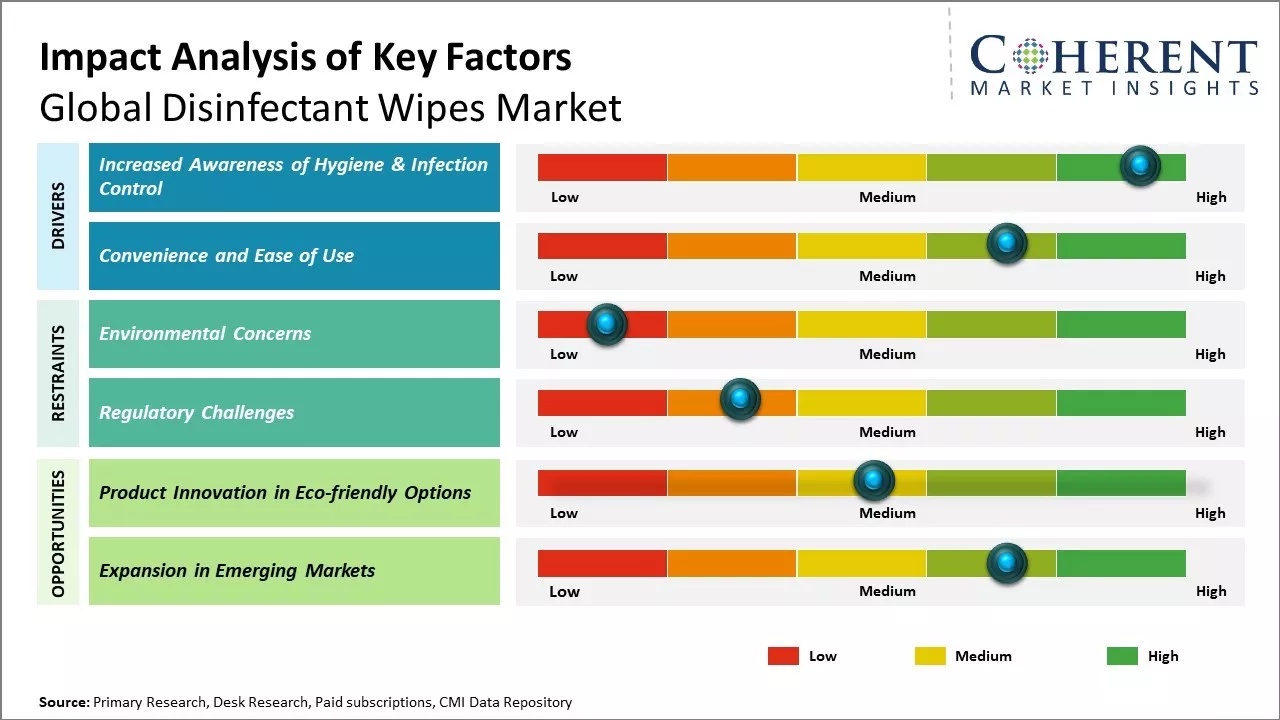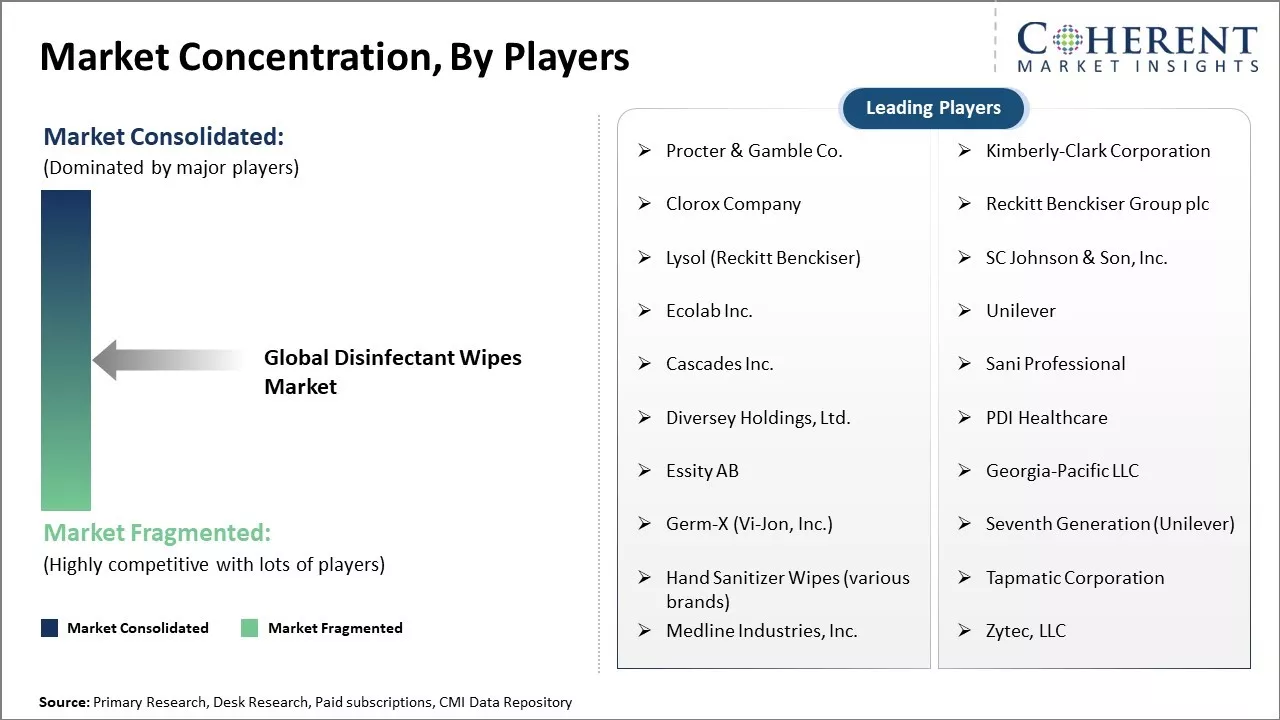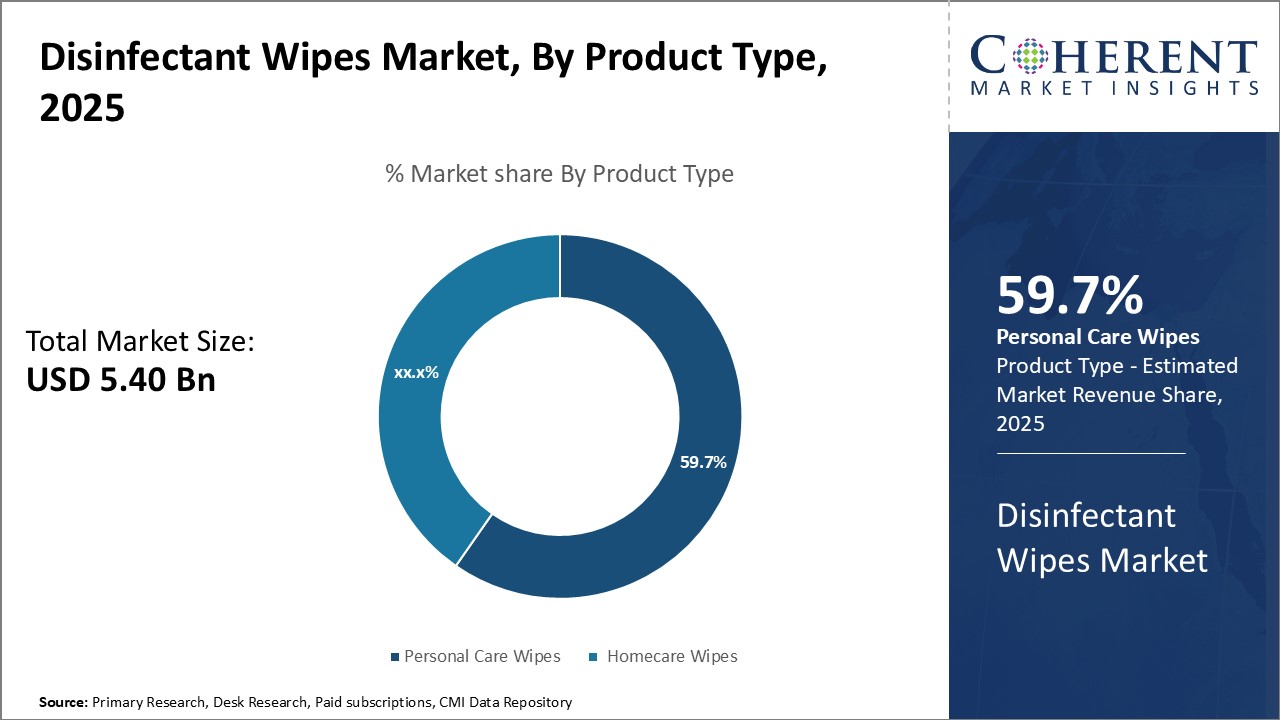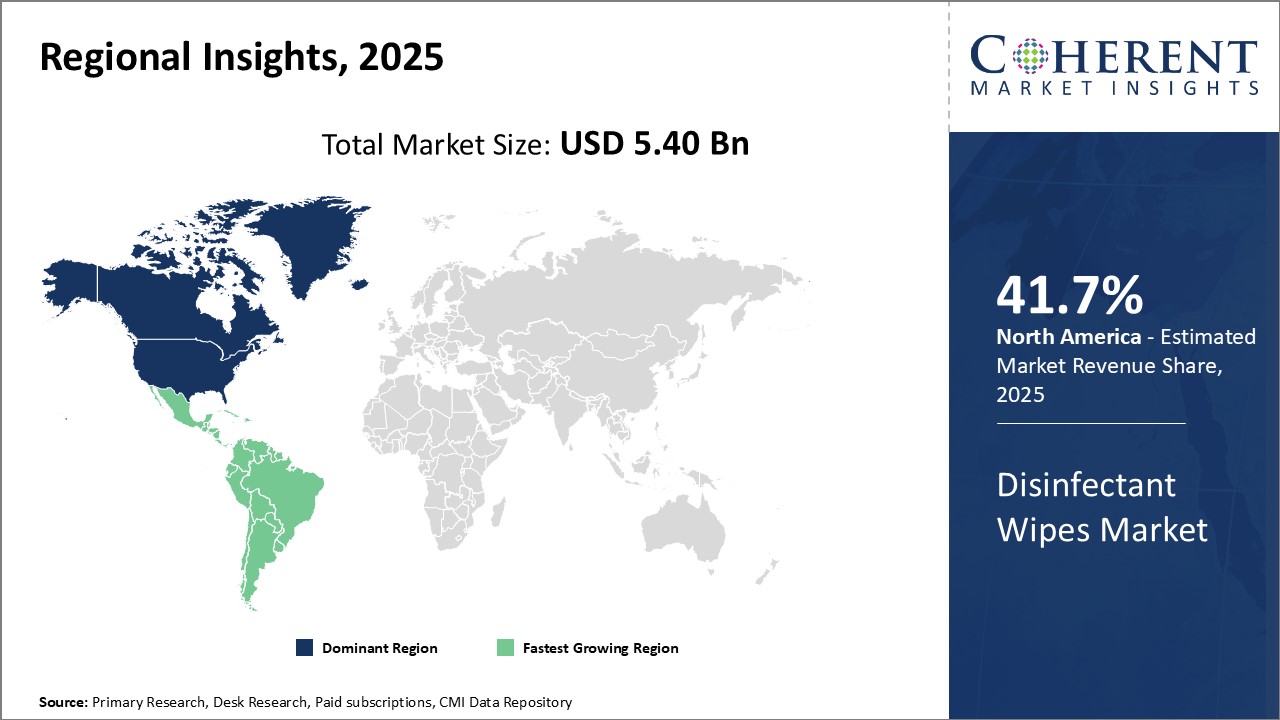Disinfectant Wipes Market Size and Trends
Global disinfectant wipes market is estimated to be valued at USD 5.40 Billion in 2025 and is expected to reach USD 8.07 Billion by 2032, exhibiting a compound annual growth rate (CAGR) of 5.9% from 2025 to 2032. Increasing awareness about importance of hygiene and cleanliness along with rising demand for convenient disinfecting products can drive the disinfectant wipes market growth.

Discover market dynamics shaping the industry: Download Free Sample
The demand for disinfectant wipes has increased significantly during the ongoing COVID-19 pandemic. People are purchasing disinfectant wipes on a large scale to sanitize surfaces regularly and reduce the risk of virus transmission. Moreover, easy availability of disinfectant wipes through multiple distribution channels including supermarkets, pharmacies, online stores and e-commerce platforms can boost sales of these products globally.
Increased awareness of hygiene & infection control
With ongoing COVID-19 pandemic, there has been increasing awareness among masses about hygiene and its impact on overall health and wellbeing. People now understand the importance of regularly disinfect commonly used surfaces as germs can spread fast through contact and lead to infections. Healthcare experts and authorities promoted frequent hand washing and surface disinfection as key measures to curtail the spread of the novel coronavirus. This heightened the importance of disinfectants in terms of preventive healthcare.
The masses closely followed news regarding the virus and safety guidelines by health organizations. These realized how easily germs can transfer from one person to another through contacts on surfaces one touch every day like doorknobs, switches, keyboards, countertops, and others. This droves people to clean household items more diligently. Disinfectant wipes have emerged as a highly convenient solution for on-the-go cleaning. Their easy portability and quick disinfecting ability through preserved moisture has made wipes a must-have in every household. People also like to keep some wipes in their bags or kits to clean phones, devices or even hands while commuting or traveling in public places.
Many organizations implemented strict hygiene protocols on workplaces that involved daily disinfection of all contact points. This has also increased commercial demand for wipes from various sectors including offices, malls, restaurants, lodging, recreational, and healthcare facilities. Educational institutes have incorporated wipe disinfection in safety guidelines upon reopening of schools and colleges. Germ control has become an important aspect of institutional management policies. Retail spaces has also started allocating dedicated areas, kiosks or staff for regular cleaning of high interaction surfaces using disinfectant wipes. For instance, in May 2022, as per the WHO's first global report on infection prevention and control (IPC), effective measures could prevent up to 70% of infections acquired in hospitals. The report highlights that a significant number of patients get infections during hospital stays- 7% in high-income countries and 15% in low- and middle-income countries. WHO urges more investment in IPC programs to protect patients and healthcare workers, reduce costs, and fight antibiotic resistance. Despite some progress, many countries, especially low-income ones, still need to improve their IPC efforts.
Market Concentration and Competitive Landscape

Get actionable strategies to beat competition: Download Free Sample
Convenience and ease of useDisinfectant wipes offer unparalleled convenience when it comes to cleaning and sanitizing. Pre-saturated with cleaning formula, these wipes are ready-to-use which eliminates the need for measuring and mixing chemicals or solutions. Their one-swipe application provides effective yet gentle disinfection in no time.
Unlike traditional cleaning methods, wipes do not require water or any other activating liquid. A single wipe is sufficient to wipe out germs from all types of surfaces. These save users from the hassle of carrying multiple supplies or equipment for disinfecting surfaces. The moist texture of wipes ensures thorough yet gentle cleaning without leaving behind any streaks or residues. This ease of use makes wipes ideal for cleaning electronics, delicate items, toys, kitchen counters and various other household surfaces.
People appreciate their hassle-free disinfection within moments. Busy consumers rely on wipes for quick yet thorough sanitization of doorknobs, switches and other surfaces while leaving home or returning from outside. Healthcare workers find wipes extremely handy for disinfecting exam rooms, medical devices and surfaces in between patient visits. Parents uses wipes for sanitizing baby items, toys and highchairs. Their fuss-free profile has also increased adoption of wipes in automotive, hospitality and sectors.
Key Takeaways from Analyst:
Global disinfectant wipes market growth is driven by increased awareness about hygiene and cleanliness among consumers due to the COVID-19 pandemic. More people are now conscious about regularly disinfecting commonly used surfaces to prevent the spread of germs and viruses. This heightened health consciousness boosts demand for these wipes.
Stringent regulations regarding infection control and prevention of hospital acquired infections can also drive the market growth. North America and Europe will remain the dominant regions due to strict guidelines for disinfectant usage. However, Asia Pacific is likely to witness the fastest growth due to improving standards of healthcare and rising individuals income in countries such as India and China.
Raw material price volatility and supply chain bottlenecks due to pandemic can hamper the market growth. The dependency on limited suppliers for core chemicals may challenge participants. Moreover, presence of alternative surface disinfecting products like sprays and liquids can take away some market share.
Ongoing R&D investments to develop innovative product formulations can create new prospects for players. Product line extensions that include moistened towelettes and baby wipes for multi-purpose cleaning are gaining popularity.
Market Challenge - Environmental concerns
Global disinfectant wipes market growth can be hampered due to environmental concerns regarding the ingredients and packaging. Most disinfectant wipes contain chemicals like triclosan and benzalkonium chloride that can raise health concerns. While these are effective against germs and bacteria, there are ongoing debates about their impact on the environment and antibiotic resistance. The wipes are also predominantly made of non-biodegradable plastics like polyethylene and polypropylene. With growing awareness about sustainability and plastic pollution, regulators and consumers demand safer alternatives. The widespread use and single-use nature of disinfectant wipes have significantly contributed to environmental waste over the years. Manufacturers will need to address these issues and resort to more eco-friendly formulations and decomposable materials to gain approvals and build long-term consumer confidence.
Market Opportunity- Product innovation in eco-friendly options
Global disinfectant wipes market can witness opportunities from product innovation in more eco-friendly options. With rising environmental concerns, consumers are increasingly looking for 'green' disinfection products that are safe for both human and environmental health. Manufacturers could develop plant-based and biodegradable wipes that contain natural and benign sanitizing agents like thymol, citric acid, essential oils, and others instead of harsh chemicals. These can also explore innovative packaging technologies and materials that have improved decomposition without releasing microplastics. Developing sustainably-sourced and packaged alcohol-based sanitizers could prove to be a game changer. Introduction of such earth-friendly alternatives will help companies tap into growing demand for eco-conscious products and position themselves as leaders in the green disinfection space. For instance, in February 2022, Lysol announced that its Disinfecting Wipes Made From 100% Plant-Based Fibers have won the 2022 "Product of the Year" award in the Disinfecting Wipes category, as voted by consumers through Product of the Year USA. These wipes are plastic-free, made entirely from plant-based fibers, and can kill 99.9% of viruses and bacteria, including the COVID-19 virus in just 30 seconds. These come in a recyclable canister and are designed for cleaning and disinfecting most hard, non-porous household surfaces.

Discover high revenue pocket segments and roadmap to it: Download Free Sample
Insights, By Product Type - Convenience and hygiene drive personal care wipes segment
In terms of product type, personal care wipes segment is estimated to contribute the highest market share of 59.7% in 2025, owing to their convenient form factor and importance placed on hygiene. These wipes are designed for personal cleansing needs and allow users to keep their hands, face and body clean throughout the day in a simple, easy to use format. As modern lifestyles get busier, consumers value products that save time spent on cleaning without compromising on hygiene. Personal care wipes can be tossed in bags and accessed anywhere, eliminating the need to carry or find access to soap, water and towels. Their single-use, pre-moistened format makes them ideally portable for on-the-go cleaning.
The COVID-19 pandemic further heightened awareness around hand and surface hygiene worldwide. Personal care wipes help supplement regular handwashing, enabling users to sanitize their hands even when soap and water are not readily available. This boosted demand as consumers sought quick and effective methods to disinfect themselves outside the home. Spending more time at home also meant families looking for easy ways to keep all household surfaces clean. Personal care wipes fulfil this need while being less messy and wasteful than sprays or liquids.
Changing social mores and awareness can also drive the segment growth. Society places greater emphasis on visible cleanliness and personal grooming. Personal care wipes aid users in achieving a cleaner appearance and feel anytime, anywhere. These allow quick fixes for situations that could compromise hygiene like dirty public surfaces, pollution, sweat or food/drink spills. This psychological need for assurance of cleanliness and appearance boosts consistent usage of personal care wipes in daily life.
Personal care wipes gain popularity due to modern preferences for convenience, hygiene accessibility and socially-driven appearance needs. Its portable, hassle-free format addresses these needs perfectly.
Insights, By Category- Sustainability benefits drive biodegradable segment
In terms of category, biodegradable wipes segment is estimated to contribute the highest market share of 59.7% in 2025, due to rising concern for environmental sustainability. These wipes are made from materials like bamboo, plant-based fibres or polymers that fully degrade without leaving harmful residues. As awareness regarding climate change increases globally, consumers increasingly consider a product's ecological impact and preferences. Biodegradable wipes provide an eco-friendly alternative to plastic-based non-biodegradable versions. These solve the issue of non-biodegradable wipes clogging landfills or releasing micro-particles when flushed.
Governments worldwide have also implemented policies pushing sustainability efforts to curb plastic waste. Many countries and states already ban or plan to prohibit the sale of non-biodegradable wipes. This regulatory support for biodegradable alternatives creates a conducive market environment. Major brands actively demonstrate commitments to developing sustainable product lines using renewable, plant-based materials. Such strategic positioning helps build positive brand perception and loyalty among eco-conscious buyers.
Biodegradable wipes perform as well as or better than their non-eco counterparts in terms of cleaning efficacy. Advancements in biopolymer R&D expanded options of home, personal and industrial-grade biodegradable wipes that resist deterioration without impacting cleaning power. This addresses previous concerns around inferior quality that limited biodegradable wipe adoption. As more sustainable solutions prove their capabilities, customer confidence in switching grows further.
With environmental protection becoming a key global priority, biodegradable wipes segment leverages its sustainability benefits to lead market share. Its ability to fulfil product functions while protecting the planet resonates with conscientious consumers.
Insights, By Product Category - Versatility drives alcohol-based wipes segment
In terms of product category, alcohol-based wipes segment is estimated to contribute the highest market share of 51.6% in 2025, due to their strong disinfecting capabilities fulfilling diverse needs. Alcohol-based formulations use ethanol or isopropyl alcohol that rapidly kill 99.9% of bacteria and viruses. This powerful antimicrobial action gives wipes versatility for cleaning surfaces and skin across different settings.
Alcohol wipes disinfect high-touch areas like door handles, faucets, switches and toys; thus, helping reduce cross-contamination. Food preparation surfaces stay bacteria-free with alcohol wipes. Their strength also makes them ideal multi-purpose cleaners for bathrooms, floors, windows and more household spots.
In professional sectors, healthcare and food & beverage industries rely on alcohol wipes daily for rigorous sanitation protocols. Isolation rooms, operating theatres and patient equipment require thorough disinfection throughout medical facilities. For food manufacturing, packaging and delivery, alcohol wipes provide a critical line of defense against contamination.
Personal hygiene also boosts usage of alcohol wipes. From killing germs on hands to disinfecting mobile phones, keyboards and outdoor equipment, the versatile format facilitates regular on-the-go cleansing. Their smaller individual packaging further supports lone traveller and commuter needs.
With COVID-19 highlighting disinfection needs, versatile alcohol wipes witness huge demand from offices, schools, public transport, sports facilities and others. Their proven ability to eliminate a wide range of illness-causing viruses and bacteria positioned alcohol wipes as a go-to preventive cleaning solution during the pandemic.
Regional Insights

Need a Different Region or Segment? Download Free Sample
North America dominates the global disinfectant wipes market with an estimated market share of 41.7% in 2025, owing to robust healthcare infrastructure and higher awareness about hygiene maintenance in both commercial as well as household settings. Stringent healthcare regulations and protocols adopted by medical facilities to control hospital-acquired infections have boosted adoption. Consumers in the region have also exhibited growing preference for convenient and quick sanitizing solutions for everyday use. Leading international players have established their manufacturing footprints across Canada and the U.S. to cater to rising regional demand and benefit from proximity to customers.
Its export potential to Latin American countries can also drive the market growth. Manufacturers have leveraged the proximity to emerging markets through effective distribution partnerships for seamless cross-border supplies. Their efforts to consolidate presence via collaborations with major distributors across Mexico and Brazil have strengthened regional hegemony in the global marketplace over the years.
Asia Pacific region has emerged as the fastest growing market for disinfectant wipes. Rapid improvements in healthcare infrastructure across India, China, and several Southeast Asian countries have augmented demand from hospitals and clinics. Growing tourism activities before the pandemic further boosted uptake of wipes in public facilities. Rising hygiene awareness among the expanding middle-class population combined with their busy lifestyles have augmented sales in the consumer segment. Export-oriented manufacturing strategies of leading European and American companies and domestic players identifying the region's untapped opportunities have augmented product availability through diverse pricing models to suit varied income groups. These factors have propelled the APAC region to the forefront of high future potential, making it one of the most promising and dynamic markets for disinfectant wipes globally.
Market Report Scope
Disinfectant Wipes Market Report Coverage
| Report Coverage | Details | ||
|---|---|---|---|
| Base Year: | 2024 | Market Size in 2025: | USD 5.40 Bn |
| Historical Data for: | 2020 To 2024 | Forecast Period: | 2025 To 2032 |
| Forecast Period 2025 to 2032 CAGR: | 5.9% | 2032 Value Projection: | USD 8.07 Bn |
| Geographies covered: |
|
||
| Segments covered: |
|
||
| Companies covered: |
Procter & Gamble Co., Kimberly-Clark Corporation, Clorox Company, Reckitt Benckiser Group plc, Lysol (Reckitt Benckiser), SC Johnson & Son, Inc., Ecolab Inc., Unilever, Cascades Inc., Sani Professional, Diversey Holdings, Ltd., PDI Healthcare, Essity AB, Georgia-Pacific LLC, Germ-X (Vi-Jon, Inc.), Seventh Generation (Unilever), Hand Sanitizer Wipes (various brands), Tapmatic Corporation, Medline Industries, Inc., Zytec, LLC |
||
| Growth Drivers: |
|
||
| Restraints & Challenges: |
|
||
Uncover macros and micros vetted on 75+ parameters: Get instant access to report
Market Segmentation
- By Product Type Insights (Revenue, USD Bn, 2020 - 2032)
-
- Personal Care Wipes
- Baby care Wipes
- Feminine Wipes
- Period Care Wipes
- Face Care Wipes
- Hand Disinfecting Wipes
- Others
- Homecare Wipes
- Personal Care Wipes
- By Category Insights (Revenue, USD Bn, 2020 - 2032)
-
- Biodegradable
- Non-biodegradable
- By Product Category Insights (Revenue, USD Bn, 2020 - 2032)
-
- Alcohol-based Wipes
- Alcohol-free Wipes
- By Distribution Channel Insights (Revenue, USD Bn, 2020 - 2032)
-
- Supermarkets/Hypermarkets
- Online Retail
- Convenience Stores
- Pharmacies and Drugstores
- Regional Insights (Revenue, US$ BN, 2020 - 2032)
- North America
- U.S.
- Canada
- Latin America
- Brazil
- Argentina
- Mexico
- Rest of Latin America
- Europe
- Germany
- U.K.
- France
- Italy
- Russia
- Rest of Europe
- Asia Pacific
- China
- India
- Japan
- Australia
- South Korea
- ASEAN
- Rest of Asia Pacific
- Middle East & Africa
- GCC Countries
- South Africa
- Rest of Middle East & Africa
- North America
- Key Players Insights
- Procter & Gamble Co.
- Kimberly-Clark Corporation
- Clorox Company
- Reckitt Benckiser Group plc
- Lysol (Reckitt Benckiser)
- SC Johnson & Son, Inc.
- Ecolab Inc.
- Unilever
- Cascades Inc.
- Sani Professional
- Diversey Holdings, Ltd.
- PDI Healthcare
- Essity AB
- Georgia-Pacific LLC
- Germ-X (Vi-Jon, Inc.)
- Seventh Generation (Unilever)
- Hand Sanitizer Wipes (various brands)
- Tapmatic Corporation
- Medline Industries, Inc.
- Zytec, LLC
Share
Share
Missing comfort of reading report in your local language? Find your preferred language :
Transform your Strategy with Exclusive Trending Reports :
Frequently Asked Questions
EXISTING CLIENTELE
Joining thousands of companies around the world committed to making the Excellent Business Solutions.
View All Our Clients
